Erica thomae
Erica thomae L.Bolus
Family: Ericaceae
Common names: flypaper heath (Eng.); vliegpapierheide (Afr.)
Introduction
Erica thomae is a variable species with white, pale green or pink, tubular, very sticky flowers over quite a long flowering period; it starts to show off its flowers from mid summer and continues into winter.
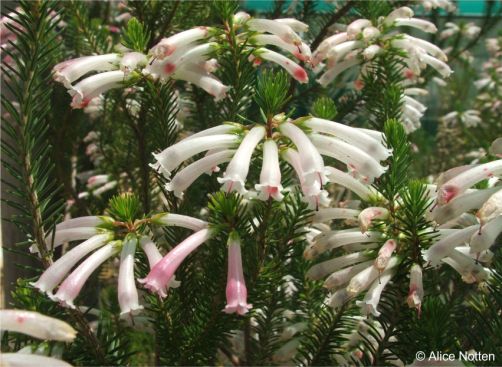
Description
Description
This heath is a variable shrublet that grows about 600 mm up to 1 m high. It has large, sticky, slightly curved tubular flowers, 20–30 mm long, that are arranged in dense whorls near the tips of the branches, and vary in colour including white, pale green, rosy pink, reddish pink, or a variety of pink shades, and deep pink with white tips. The corolla has longitudinal ridges, and the anthers do not protrude from the mouth of the flower. It has been observed that the plants producing the pink flowers are more floriferous and grow about 350 mm taller than the white forms. Flowering occurs from mid summer to winter (December to July).
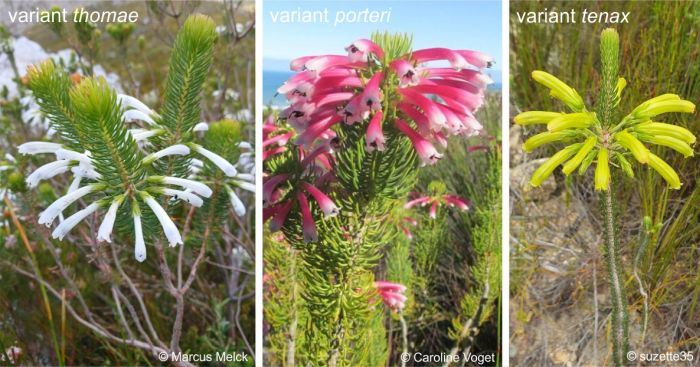
Erica thomae includes two formerly recognised taxa, Erica porteri and Erica tenax, that are now synonyms of Erica thomae. These species all have similar flowers and vary mainly in the size and thickness of the leaves, the length of the pedicels and the colour and size of the flowers, but there are intermediates and no clear-cut discontinuities to justify keeping them in separate taxons and they are now regarded as variants of a single species.
Variant thomae, formerly Erica thomae sensu stricto, (flypaper heath), has medium to long pedicels (6–10 mm long), white, rose pink or reddish pink flowers with or without paler tips and the corolla is 22–30 mm long. It occurs in the northern and eastern parts of the distribution range, Kogelberg, Hangklip and Betty’s Bay.
Variant porteri, formerly Erica porteri (Porter’s heath) has short pedicels (4–7 mm long), dark reddish pink flowers with white tips and the corolla is 20–25 mm long. It originates as a single population in Buffelsrivier Valley near Pringle Bay and is named after Harold Porter.
Variant tenax, formerly Erica tenax (green flypaper heath) has long pedicels (13–16 mm long), light green to white flowers and the corolla is 22–30 mm long. It is often seen growing in seepage areas but also in dry sandy soil among rocks, in the northern and eastern parts of the distribution range, near Kleinmond.
Conservation Status
Status
This plant is allocated the national status of Rare by the Red List of South African Plants, due to its relatively small natural range. However, it is locally common, and its habitat is quite safe and well protected inside a reserve, and it is not facing any threats, thus under the IUCN 3.1 categories this species also meets the criteria for Least Concern (LC).
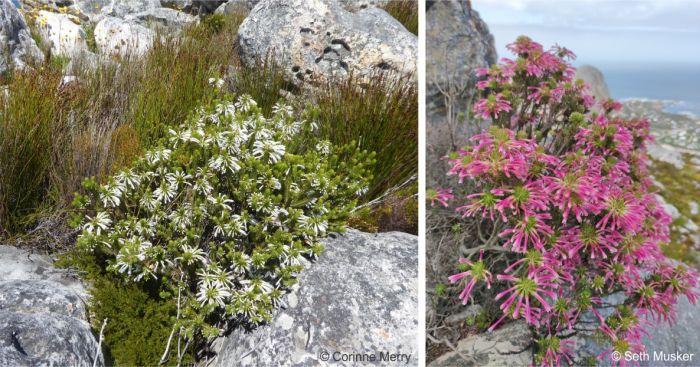
Distribution and habitat
Distribution description
The Western Cape Province of South Africa is home to Erica thomae where it is endemic to the Kogelberg Mountains, occuring from Kogelberg to Hangklip to Kleinmond. It establishes itself among boulders and rocks on sandstone slopes, where it grows undisturbed, except for the possible future threat of encroachment by invasive alien species.
Derivation of name and historical aspects
History
The genus name Erica derives from the Latin word ereiko which means ‘heath’ or ‘broom’. The specific epithet thomae refers to Thomas P. Stokoe, the person who provided the type material to Louisa Bolus, and she named the plant in honour of him. In 2002 when Oliver and Oliver redefined this species, two of the species shared the earliest publication date, Erica thomae and E. tenax were described in the same journal, but they decided to keep the epithet thomae in recognition of Thomas Stokoe’s considerable collections of fynbos plants. The epithet tenax is Latin meaning ‘tenacious’ or ‘holding fast’, referring to the sticky flowers.
Erica thomae is a member of the Ericaceae family. The genus Erica is quite large, it comprises about 850 species, of which 700 species are only found in South Africa, with 600 species occurring in the Cape Floristic Region. Europe, Madagascar and the Mediterranean region are also known for being home to certain Erica species.
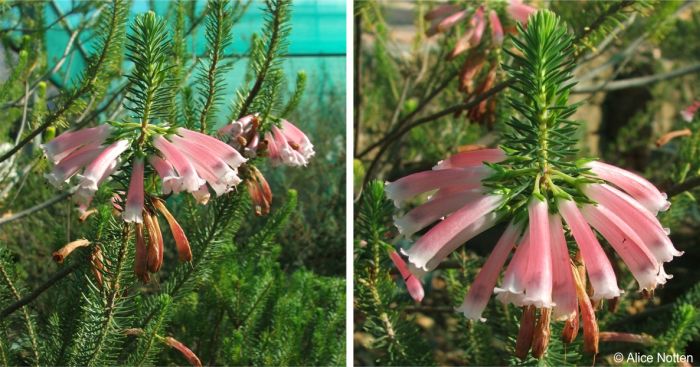
Ecology
Ecology
Erica thomae flowers are seen being visited by sunbirds, that pollinate the flowers while feeding on the nectar inside, the different flower colours in some way aiding pollination and the size and shape of the flowers matching the size and curve of the bird’s beak. The stickiness of the flowers does not prevent or impede feeding by birds, however crawling and flying insects are trapped on the sticky flowers, preventing them from feeding on the nectar and pollen in the flower. Erica thomae is adapted to grow among rocks and this may be a survival strategy against threats such as being eaten by some herbivores and avoiding fires. Erica thomae seeds are minute and are easily dispersed by wind.
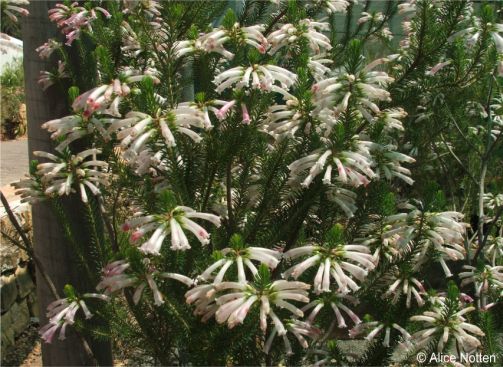
Uses
Use
Erica thomae adapts well as a pot plant provided that the pot drains well and that the pot medium is in the acidic range of at least 5.5. This heath is ideal for fynbos gardens, plant it in an open, sunny position, where the soil drains well and the air is free-moving.
Growing Erica thomae
Grow
Propagate Erica thomae from semi-hardwood heel cuttings, and make the cuttings 40-50 mm long. Nodal cuttings can also be used, however, heel cuttings proved to be more successful. Make sure to select healthy plant material to prevent combatting fungal infections and other pests at a later stage. Use a rooting medium of fine-milled bark and perlite balls at a 50:50 ratio to ensure the medium is well drained. Place the cuttings on a propagation bench kept at 24°C to enhance root development.
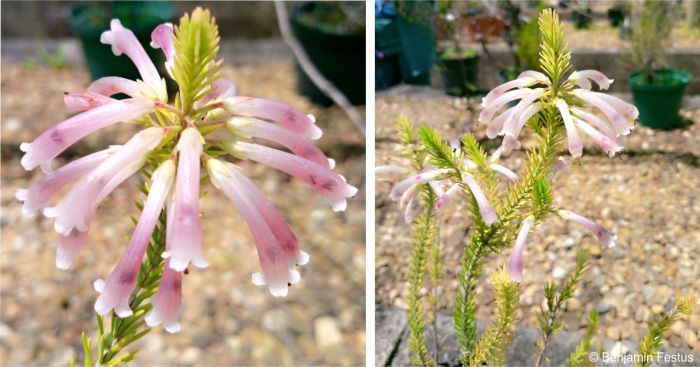
Transplant rooted cuttings into small pots using 7 parts milled bark and 3 parts sand. Propagating by cuttings is a much faster method, compared to sowing seeds, to develop a successful young plant. Place the cuttings in a hardening-off area for a month before exposing them to open environmental conditions. The cuttings can be successfully planted out after three months.
Soak seeds in a fynbos smoke extract to break the dormancy, this will speed up germination which usually takes up to eight weeks. Prepare 100 mm deep seed trays to sow the seeds in by filling them with river sand and sifted composted bark at a 50:50 ratio. Mix the seeds with dry river sand and spread the mixture evenly on top of the medium, this method will prevent seeds from being planted too densely. Water the medium lightly, to prevent washing the seeds out of position, and shelter from direct sunlight. Feed the young seedlings with an organic liquid fertiliser every second week.
Grow the plants in a full sun position in the garden, they must have good drainage and maintain enough space between them to provide ventilation, this will discourage the growth of fungal disease. Prune the plant regularly after flowering, pruning to encourage new growth and will get rid of damaged or dead wood. Do not use a garden fork or spade to cultivate near the root zone of the plant use hand tools because the hairlike roots can be easily damaged. Weeds can be controlled by adding mulch to the plant beds, which will also reduce water evaporation. Erica thomae can also be grown successfully in rock gardens.
Control mealybug on young plants using an organic pesticide, or a systemic pesticide added to the medium. Manage the drainage of containers to prevent root disease.
References
- BiodiversityExplorer. Erica thomae https://www.biodiversityexplorer.info/plants/ericaceae/erica/erica_thomae.htm. Accessed 5 December 2024.
- Goldblatt, P. & Manning, J. 2000. Cape Plants. A conspectus of the Cape flora of South Africa. Strelitzia 9. National Botanical Institute, Pretoria & Missouri Botanical Garden, Missouri.
- iNaturalist. Flypaper Heath (Erica thomae). https://www.inaturalist.org/taxa/585234-Erica-thomae. Accessed 5 December 2024.
- Melck, M. 2023-Nov. Observation of Erica thomae var. thomae, Kogelberg Nature Reserve. iNaturalist. Online. https://www.inaturalist.org/observations/193196535.
- Merry, C. 2020-Dec. Observation of Erica thomae var. thomae. Kogelberg. iNaturalist. Online. https://www.inaturalist.org/observations/66652777.
- Munro, F., Turner, R.C., Oliver, E.G.H. & Von Staden, L. 2023. Erica thomae L.Bolus. National Assessment: Red List of South African Plants. http://redlist.sanbi.org/species.php?species=1820-873.
- Musker, S. 2021-Feb. Observation of Erica thomae var. porteri, Rooielsberg. iNaturalist. Online. https://www.inaturalist.org/observations/69253557.
- Oliver, E.G.H. & Oliver, I.M. 2002. The genus Erica (Ericaceae) in southern Africa: taxonomic notes 1. Bothalia 32(1):37–61.
- Rebelo, T. 2023-03-25. Erica porteri, Erica tenax and Erica thomae. iNaturalist. Ericas of Southern Africa’s Journal. https://www.inaturalist.org/projects/ericas-of-southern-africa/journal/76988-erica-porteri-erica-tenax-and-erica-thomae.
- suzette35. 2024-Jan. Observations of Erica thomae var.tenax, Kleinmond. https://www.inaturalist.org/observations/195944192, 195848339, 195848327 & 195848259.
- Voget, C. 2016-May. Observation of Erica thomae var. porteri, Betty’s Bay. iNaturalist. Online. https://www.inaturalist.org/observations/11209574.
- World Flora Online. Erica thomae L.Bolus. http://www.worldfloraonline.org/taxon/wfo-0000673411. Accessed 05 December 2024.
Credits
Benjamin Festus and Alice Notten
Kirstenbosch National Botanical Garden
December 2024
Acknowledgements: images by Benjamin Festus, Alice Notten, Suzette35, Marcus Melck, Seth Musker, Corinne Merry and Caroline Voget.
Plant Attributes:
Plant Type: Shrub
SA Distribution: Western Cape
Soil type: Sandy
Flowering season: Late Summer, Autumn, Winter
PH: Acid
Flower colour: White, Pink, Yellow
Aspect: Full Sun
Gardening skill: Average
Special Features:
Horticultural zones
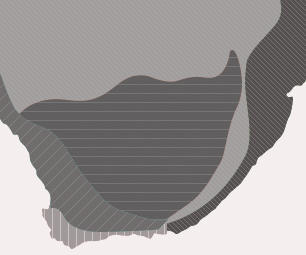






Rate this article
Article well written and informative
Rate this plant
Is this an interesting plant?
Login to add your Comment
Back to topNot registered yet? Click here to register.